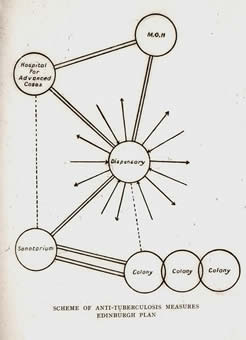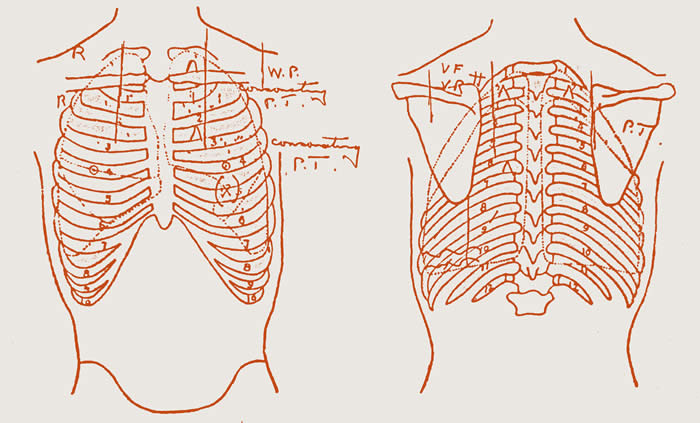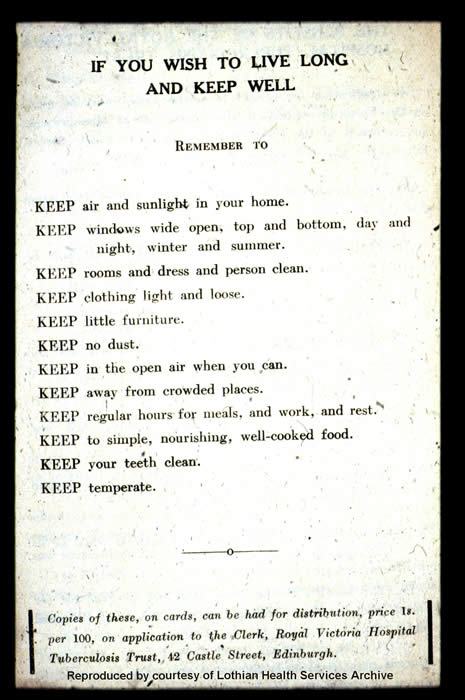


Projects
RVH vs TB: a project to catalogue LHSA’s Royal Victoria Hospital Tuberculosis and Diseases of the Chest Case Notes and Registers (c.1920-2000)
The RVH v TB project, funded by the Wellcome Trust, has set out to catalogue the c.25, 000 folder-based case notes from the Royal Victoria Tuberculosis Trust and associated hospitals. This project will see the creation of the first item-level, ISAD(G) compliant catalogue of tuberculosis and diseases of the chest case notes, which will open up this valuable resource to researchers at all levels.
These records cover a period in which changes in treatment methods saw death rates from tuberculosis in Scotland fall from 130 to 13 per 100,000. They provide evidence of the change in treatment from sanatorium regimes, surgery, and therapies such as tuberculin or sanocrysin (gold) to the effective antibiotic treatments in use today.
The Royal Victoria Tuberculosis Trust
The Royal Victoria Tuberculosis Trust was established by Sir Robert Philip, an Edinburgh-based doctor and a pioneer in the public health response to tuberculosis. He established the world’s first tuberculosis dispensary in 1887, which would become a cornerstone of the so-called ‘Edinburgh Scheme’, examining the contacts of known cases of tuberculosis and providing education on hygienic living in order to catch the disease early and curb its spread. This influenced the wider response to tuberculosis treatment throughout the UK, notably through the legislative drive for the notification of tuberculous patients to local Medical Officers for Health.
Cataloguing case notes
Case notes are patient records that contain highly sensitive information, raising issues surrounding confidentiality. Encoded Archival Description (an XML-based cataloguing standard) allows us to remove identifying information from the public catalogue in accordance with UK data legislation and Scottish Government guidelines. Access to an unredacted catalogue is possible after a successful application to NHS Lothian via LHSA.
In cataloguing the records to individual level we are able to create a finding aid which respects the character of the case notes and meets the needs of a variety of researchers. The methodology used for the Dott project has been adopted, so that attributes such as locations, occupations, gender, and medical conditions can be indexed and searched. Adaptations have been made to reflect the infectious nature of the disease. The location of a patient is recorded in slightly more detail, though without compromising the anonymity of patients; additionally, a note is made of any family history of tuberculosis, as is recorded in the case notes.
Although this is in many respects a similar project to the Dott project, there are some key differences in the records which bring a unique set of challenges. The Dott case notes are extensive, and carefully typed, whereas the RVH case notes are short and handwritten, often using obscure and unique abbreviations which are difficult to interpret. In addition, poor recordkeeping practices at the time have led to at times scanty and incomplete records being created. Cataloguing is therefore often slower as handwriting, symbols and abbreviations must be interpreted, and information about treatments often needs to be carefully teased out of the records.
The case notes are in four series, coming from three distinct organisations within the trust: the Dispensary, a first point of contact for patients and their contacts and a treatment centre for patients for whom inpatient care was unsuitable; Southfield Sanatorium, which provided long-term inpatient care for paying patients or patients paid for by other Scottish local authorities; and Mass Radiography recall letters, from the successful scheme to X-ray the public and discover symptomless cases of tuberculosis. They reflect the range of work which the trust carried out, from screenings of known contacts of TB and the wider public, to treatment of the disease, and follow-up of healed or inactive cases.
More information on the project and ongoing updates can be found on the LHSA blog.
Designed by the Learning Technology Section, © The University of Edinburgh

